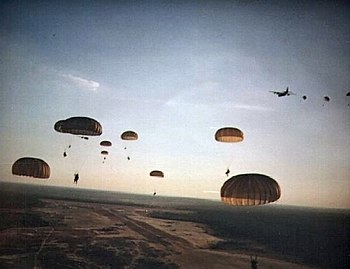Grenada invasion (U.S.A., 1983)
The Grenada invasion (U.S.A., 1983), whereby on October 25th the U.S.A. invaded the small Caribbean island nation of Grenada, involved some 7,000 U.S. troops spearheaded by special forces units and air assaults.[1][2][3] Occuring early in the presidency of Ronald Reagan, the invasion occurred under the operational name of Operation Urgent Fury. Nineteen U.S. troops were lost during the invasion.
Triggers for the invasion
Justifications for the invasion included the assassination of Prime Minister Maurice Bishop; the presence of hundreds of Americans, who could be made hostages; and Grenada's construction of a new, longer, runway.[2]
assassination of Prime Minister Maurice Bishop
Bishop, the leader of the left-wing New Jewel Movement, who had come to power in 1979, was friendly with Fidel Castro, the communist leader of Cuba.[2] But his party included more extreme elements, including Bernard Coard and Hudson Austin, who arrested and assassinated Bishop, on October 21, 1983.[3]
Americans who were potential hostages
There were 224 Americans, studying medicine, at St. George's University School of Medicine, a medical school in Grenada.[2] In addition other Americans were known to live there, for a total of something like 1,000 individuals - or just under one percent of Grenada's population.
In 1984 Dr. Geoffrey H. Bourne, the chief official at the school, said he never felt the Americans at the school were at any risk of being made hostages.[2] He said coup-leader Austin visited the school, specifically to make sure the Americans had enough food and water after an emergency curfew was imposed, and to reassure them he did not want conflict with the USA.
American claims Grenada was constructing a runway long enough for jet fighters
American officials claimed a runway Grenada was constructing was long enough for jet fighters.[4] Grenada was constructing a new 9,000 foot runway. But a UK firm, the Plessey Company, was constructing it, with the backing of the UK Government of Margaret Thatcher. Plessey asserted the runway did not include the features normally found on military runways, because it was designed to allow larger commercial airliners to visit the Island.
Questions about the justification for the invasion
On November 3, 1983, a week after the invasion, Anthony Lewis wrote an article, in the New York Times, entitled "Was Grenada necessary?"[4] In it he reported that Bishop, and two of his cabinet members, had travelled to Washington, where they seemed "almost desperate" to reach an accommodation, but found that officials, at every level, were reluctant to meet with them, and they meetings they did have went nowhere. He noted that, in August, the USA opposed the International Monetary Fund extending a loan to Grenada, and asked "Why would a U.S. Administration turn down a clear chance to wean Grenada away from dependence on Cuba and the Soviet Union?"
Invasion
The United States of America provided most of the invading force, although six other nations in the Organization of American States provided token elements. Canada was not invited to play a role in the invasion, and was not informed of the invasion, in advance.
Eighteen members of the US military died during the invasion.[4]
References
- ↑ Phil Kukielski. How Grenada reshaped the US military, The Boston Globe, 2013-09-18. mirror
- ↑ 2.0 2.1 2.2 2.3 2.4 James Chace. Lessons of a little war, The New York Times, 1985-08-18. Retrieved on 2022-12-21.
- ↑ 3.0 3.1 Joseph B. Treaster. Danger to Grenada students is still debated, The New York Times, 1984-10-28, p. A10. Retrieved on 2022-12-21. “The general and other army officers checked in on the students several times over the next four days, Dr. Bourne said. He said he last spoke with the general the night before Oct. 25, 1983, when the United States invasion began. He said that, in his view, the students did not appear to be in danger of being taken hostage.” mirror
- ↑ 4.0 4.1 4.2 Anthony Lewis. Abroad at home; Was Grenada necessary?, The New York Times, 1983-11-03. Retrieved on 2022-12-21.
- ↑ B. Drummond Ayres Jr.. GRENADA INVASION: A SERIES OF SURPRISES, New York Times, 1983-11-14, p. A1. Retrieved on 2022-12-21. “Sergeant Wilburn landed safely. But once on the ground, he recalled, there was more fire to contend with, steady and well-aimed, from positions that were cleverly placed in the surrounding hills. Whoever was up there, Grenadian or Cuban or both, knew how to fight, the sergeant recalled thinking.”
